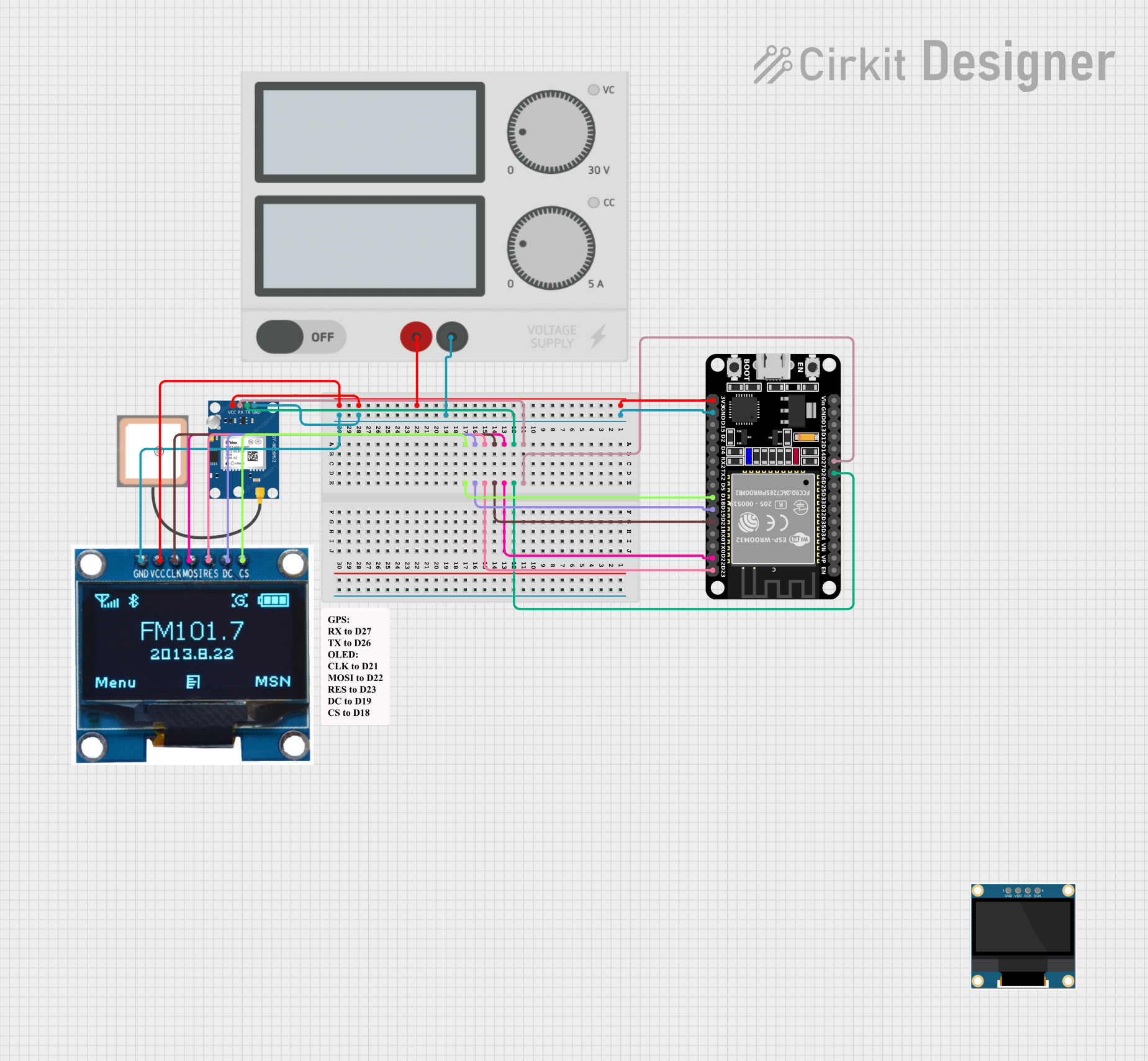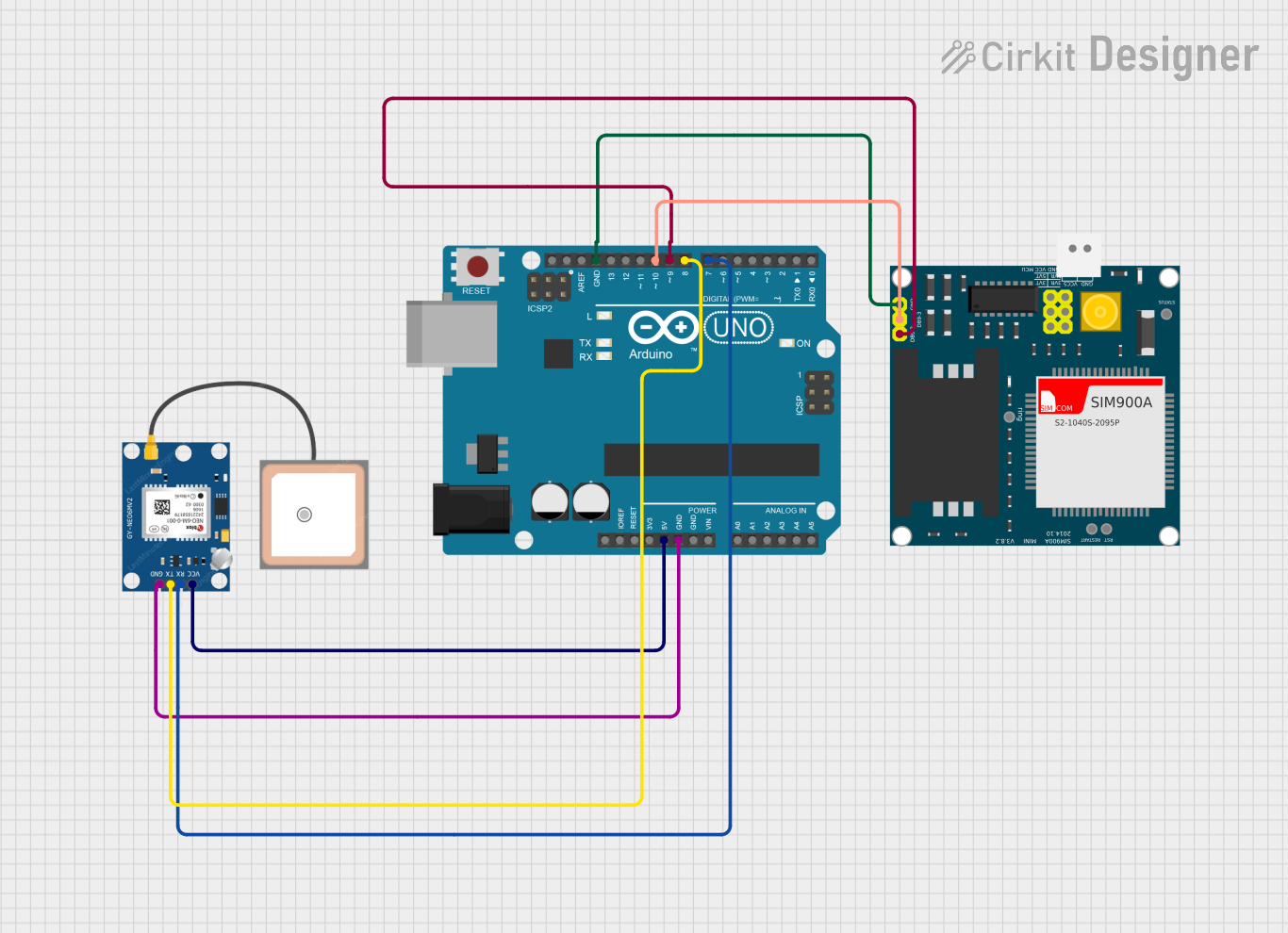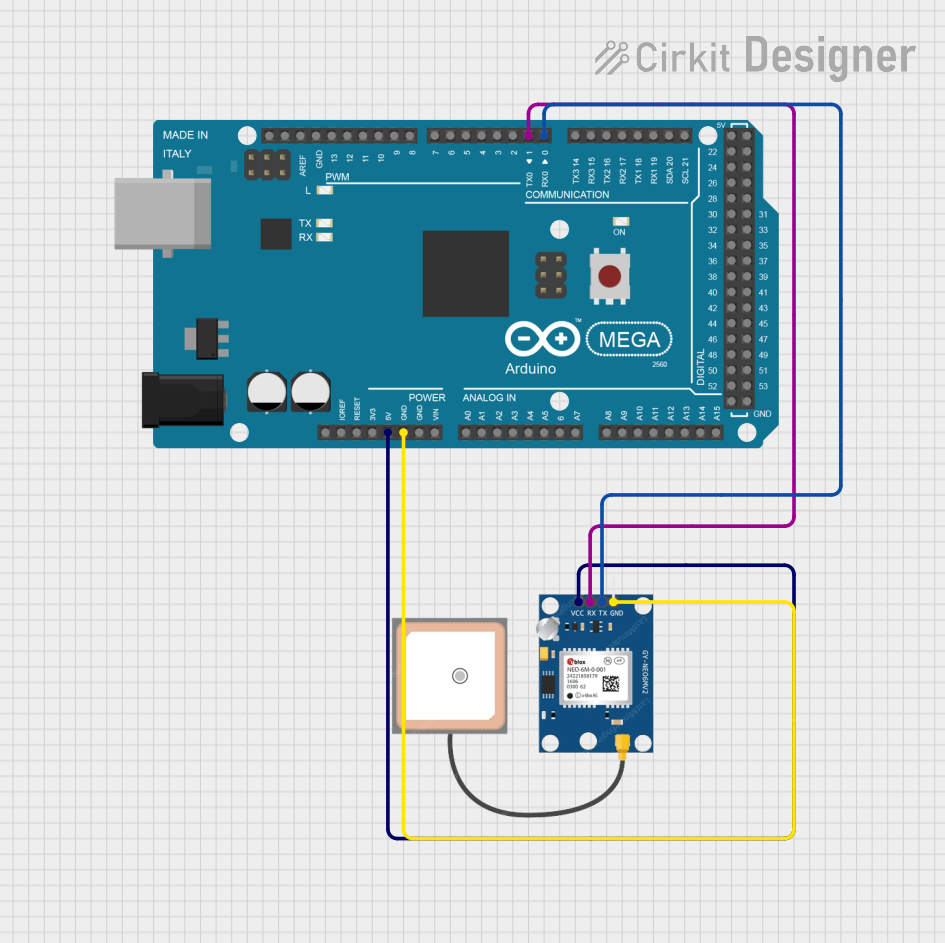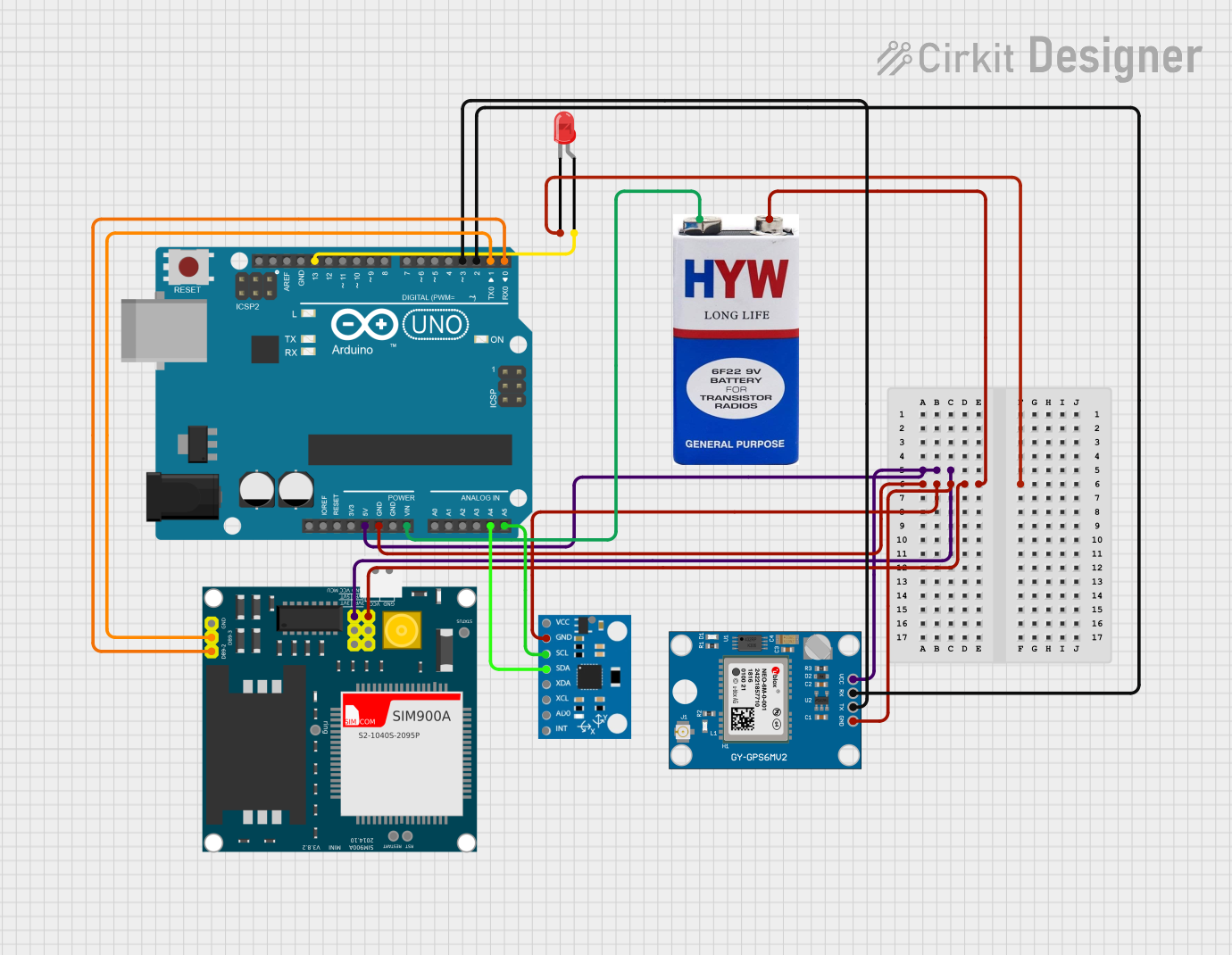
How to Use GPS whada neo 7 m: Examples, Pinouts, and Specs

 Design with GPS whada neo 7 m in Cirkit Designer
Design with GPS whada neo 7 m in Cirkit DesignerIntroduction
The GPS Whada Neo 7 M is a high-performance GPS module designed to deliver accurate and reliable positioning data. Its compact design and low power consumption make it ideal for a wide range of applications, including robotics, drones, navigation systems, and IoT devices. The module supports multiple satellite systems, such as GPS, GLONASS, and QZSS, ensuring enhanced reliability and faster positioning even in challenging environments.
Common applications of the GPS Whada Neo 7 M include:
- Autonomous navigation for drones and robots
- Vehicle tracking and fleet management
- Geolocation for IoT devices
- Outdoor navigation systems
- Timing synchronization in communication systems
Explore Projects Built with GPS whada neo 7 m

 Open Project in Cirkit Designer
Open Project in Cirkit Designer
 Open Project in Cirkit Designer
Open Project in Cirkit Designer
 Open Project in Cirkit Designer
Open Project in Cirkit Designer
 Open Project in Cirkit Designer
Open Project in Cirkit DesignerExplore Projects Built with GPS whada neo 7 m

 Open Project in Cirkit Designer
Open Project in Cirkit Designer
 Open Project in Cirkit Designer
Open Project in Cirkit Designer
 Open Project in Cirkit Designer
Open Project in Cirkit Designer
 Open Project in Cirkit Designer
Open Project in Cirkit DesignerTechnical Specifications
The GPS Whada Neo 7 M module is packed with advanced features to ensure high performance and versatility. Below are its key technical specifications:
| Parameter | Specification |
|---|---|
| Satellite Systems | GPS, GLONASS, QZSS |
| Positioning Accuracy | 2.5 meters CEP |
| Update Rate | Up to 10 Hz |
| Input Voltage | 3.3V to 5V |
| Power Consumption | 45 mA (typical) |
| Communication Interface | UART (default), I2C, SPI |
| Baud Rate (Default) | 9600 bps |
| Operating Temperature | -40°C to +85°C |
| Dimensions | 16 mm x 12.2 mm x 2.4 mm |
| Antenna | External active antenna (included) |
Pin Configuration and Descriptions
The GPS Whada Neo 7 M module has a standard pinout for easy integration into circuits. Below is the pin configuration:
| Pin | Name | Description |
|---|---|---|
| 1 | VCC | Power supply input (3.3V to 5V) |
| 2 | GND | Ground connection |
| 3 | TX | UART Transmit (data output from the GPS module) |
| 4 | RX | UART Receive (data input to the GPS module) |
| 5 | PPS | Pulse Per Second output for timing synchronization |
| 6 | SDA | I2C Data Line (optional communication interface) |
| 7 | SCL | I2C Clock Line (optional communication interface) |
| 8 | EN | Enable pin (active high, used to power on/off module) |
Usage Instructions
How to Use the GPS Whada Neo 7 M in a Circuit
- Power Supply: Connect the VCC pin to a 3.3V or 5V power source and the GND pin to ground.
- Communication Interface: Use the TX and RX pins for UART communication. Ensure the baud rate of your microcontroller matches the module's default baud rate (9600 bps).
- Antenna Connection: Attach the included external active antenna to the module for optimal signal reception.
- Microcontroller Integration: Connect the TX pin of the GPS module to the RX pin of your microcontroller and the RX pin of the GPS module to the TX pin of your microcontroller.
- Optional Features: Use the PPS pin for precise timing applications or the I2C interface (SDA and SCL pins) for alternative communication.
Important Considerations and Best Practices
- Place the GPS module in an open area with a clear view of the sky for optimal satellite reception.
- Avoid placing the module near high-frequency noise sources or metal objects that may interfere with the signal.
- Use a level shifter if your microcontroller operates at 3.3V logic levels and the GPS module is powered at 5V.
- Allow the module a few seconds to acquire satellite signals after powering on.
Example Code for Arduino UNO
Below is an example code to interface the GPS Whada Neo 7 M with an Arduino UNO using the SoftwareSerial library:
#include <SoftwareSerial.h>
// Define RX and TX pins for SoftwareSerial
SoftwareSerial gpsSerial(4, 3); // RX = Pin 4, TX = Pin 3
void setup() {
Serial.begin(9600); // Initialize Serial Monitor at 9600 bps
gpsSerial.begin(9600); // Initialize GPS module at 9600 bps
Serial.println("GPS Whada Neo 7 M Test");
}
void loop() {
// Check if data is available from the GPS module
while (gpsSerial.available()) {
char c = gpsSerial.read(); // Read a character from the GPS module
Serial.print(c); // Print the character to the Serial Monitor
// Note: Use a GPS parsing library like TinyGPS++ for advanced functionality
}
}
Notes:
- Connect the GPS module's TX pin to Arduino's pin 4 and RX pin to Arduino's pin 3.
- Install the TinyGPS++ library for advanced parsing of GPS data, such as latitude, longitude, and time.
Troubleshooting and FAQs
Common Issues and Solutions
No Data Output from the GPS Module
- Cause: Incorrect wiring or baud rate mismatch.
- Solution: Verify the connections between the GPS module and the microcontroller. Ensure the baud rate is set to 9600 bps.
Poor Satellite Signal Reception
- Cause: Obstructions or interference.
- Solution: Place the module in an open area with a clear view of the sky. Ensure the antenna is securely connected.
Module Not Powering On
- Cause: Insufficient power supply or incorrect voltage.
- Solution: Check the power supply voltage (3.3V to 5V) and ensure proper connections to the VCC and GND pins.
Data Appears as Gibberish on Serial Monitor
- Cause: Baud rate mismatch.
- Solution: Ensure the baud rate in your code matches the GPS module's default baud rate (9600 bps).
FAQs
Q: Can the GPS Whada Neo 7 M work indoors?
A: While the module can function indoors, satellite signal reception may be weak or unavailable. For best results, use the module outdoors.
Q: How long does it take to acquire a GPS fix?
A: The time to acquire a fix depends on the environment. A cold start may take up to 30 seconds, while a warm start typically takes a few seconds.
Q: Can I use the module with a 3.3V microcontroller?
A: Yes, the module is compatible with 3.3V microcontrollers. Ensure the power supply voltage matches the module's requirements.
Q: What is the purpose of the PPS pin?
A: The PPS (Pulse Per Second) pin provides a precise timing signal that can be used for synchronization in time-sensitive applications.
Q: Does the module support higher update rates?
A: Yes, the module supports update rates of up to 10 Hz. However, higher update rates may increase power consumption.